

However, these cognitive impairment varies among different individuals. Age-associated cognitive decline. Sedentary behavior as a risk factor for cognitive decline? What is the association between sedentary.
Mild Cognitive Impairment. Exercise increases the hippocampus volume which increases memory function. Effects of Interactive Video Game Training on cognitive function in older adults. The Neuroprotective Effects of Exercise. Tai chi for balance, sleep quality and cognitive performance. Physical activity improves gaze and posture control in the elderly. Aerobic exercise training increases brain volume in aging humans. - PubMed - NCBI.
Cognitive and Intellectual Contributions of Playing Scrabble. Last Updated on September 4, 2018 Across the world, numerous generations of children grew up playing scrabble.
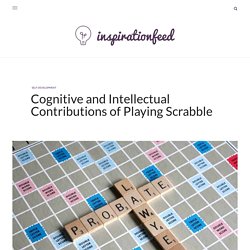
According to child development experts, this is a beneficial thing, because Scrabble offers multiple cognitive and intellectual advantages to its players. Besides, some social advantages seem to surface from playing scrabble. Adults can also benefit from playing the game because it maintains the brain’s plasticity. If you want to learn more about all the cognitive and intellectual contributions of scrabble, keep reading below. Scrabble – A Short History Before illustrating the numerous developmental benefits of playing Scrabble, you should know that the game was invented in 1938. The idea came to Butts after reading The Gold Bug, an Edgar Allan Poe short story. James Brunot also renamed the game Scrabble and finished it in the form we know today. Cognitive activity relates to cognitive performance but not to Alzheimer disease biomarkers. - PubMed - NCBI. Why mental arithmetic is the best exercise for a brain? - The human brain has the same general structure as the brain of other mammals, but has a larger size relative to body weight.
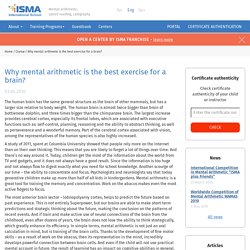
The human brain is almost twice bigger than brain of bottlenose dolphin, and three times bigger than the chimpanzee brain. The largest increase provides cerebral cortex, especially its frontal lobes, which are associated with executive functions such as: self-control, planning, reasoning and the ability to abstract thinking, as well as perseverance and a wonderful memory.
Part of the cerebral cortex associated with vision, among the representatives of the human species is also highly increased. A study of 2011, spent at Columbia University showed that people rely more on the Internet than on their own thinking. This means that you are likely to forget a lot of things over time. The most anterior brain sector – lobnopolyarny cortex, helps to predict the future based on past experience. And yet, try not to spoil your child with cell phones. Crochet therapy. Brain Training Games Enhance Cognitive Function in Healthy Subjects. Explicit and implicit memory for music in healthy older adults and patients with mild Alzheimer’s disease. Association of Crossword Puzzle Participation with Memory Decline in Persons Who Develop Dementia. Chess Practice as a Protective Factor in Dementia. Participating in social activities helps preserve cognitive function.
What’s cooking? – Cognitive training of executive function in the elderly. Social activities lengthen life in elderly Americans. Cognitive Benefits of Social Dancing and Walking in Old Age: The Dancing Mind Randomized Controlled Trial. $3b plan to help seniors stay active. SINGAPORE — In a concerted push to help the growing population of seniors here lead more active and fulfilling lives in their golden years, the Ministerial Committee on Ageing today (Aug 26) announced a comprehensive raft of initiatives spanning areas such as lifelong learning, employment, housing volunteerism.
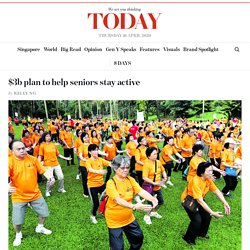
The centrepiece of this S$3 billion national blueprint — put together after a year of consultations with some 4,000 Singaporeans from various walks of life — is a new network of community and educational institutions that will roll out more than 30,000 learning places for seniors by 2030. Called the National Silver Academy, it will comprise up to 100 voluntary welfare organisations, community organisations and post-secondary education institutions when it is launched next year. It aims to curate a wide range of courses in areas such as information technology, social media, photography and the arts, which seniors can take up not only for employment, but also for interest. People's Association. Senior Citizens' Executive Committees PA Senior Citizens’ Executive Committees (SCECs) is the largest seniors’ network in Singapore.
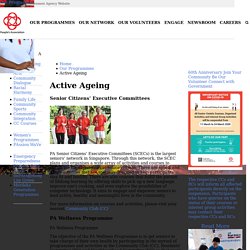
Active Ageing Hub. The "A, B, C"S of ageing well. Through the Community Network for Seniors (CNS), Government agencies and community partners work together to bring “ABC” – Active Ageing, Befriending, and Care and Support to help seniors age gracefully.

Active Ageing Help your loved ones stay active, healthy and socially engaged with these programmes near your neighbourhood: Download the Moments of Life App to Stay Active, Healthy and Connected! Use it to download your Merdeka Generation e-card for use at select merchant outlets and CHAS clinics, find active ageing programmes near you, or view your personalised government benefits! National Steps Challenge™ Season 5 is here! Never Too Late for Elderly to Start Exercising. How to Live Longer How would you like to extend your life without having to make much of a sacrifice?
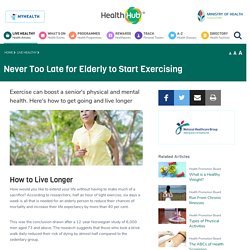
According to researchers, half an hour of light exercise, six days a week is all that is needed for an elderly person to reduce their chances of mortality and increase their life expectancy by more than 40 per cent. This was the conclusion drawn after a 12-year Norwegian study of 6,000 men aged 73 and above. The research suggests that those who took a brisk walk daily reduced their risk of dying by almost half compared to the sedentary group.